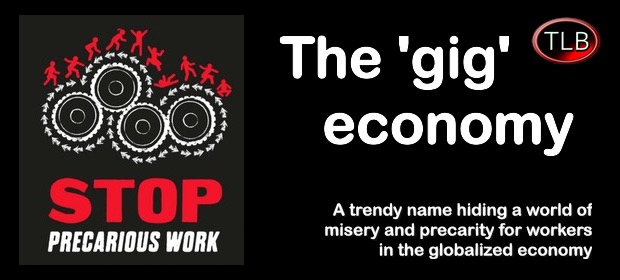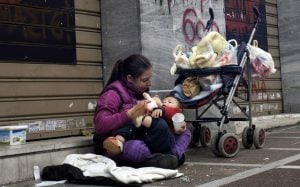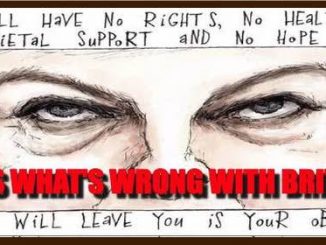
The “Gig Economy”: Global Unemployment, Low Wages, Migration and the Future Workplace
The author tracks key economic forces that have resulted in technological innovations which have given birth to the gig economy that is threatening job security, the gigzombie who is the alienated worker in the gig economy, and misguided anger directed at immigrants.
“A gig economy is an environment in which temporary positions are common and organizations contract with independent workers for short-term engagements. The trend toward a gig economy has begun. A study by Intuit predicted that by 2020, 40 percent of American workers would be independent contractors.”
Introduction
This article explains sweeping changes that have resulted in the gig economy and migration patterns. The gig economy is the future workplace, once associated with less industrialized countries in the 1970s, where temporary, unstable employment is commonplace and companies tend toward hiring employees who are all but in name performing the work of permanent workers, but are denied permanent employee rights. It undermines the traditional economy and will aggravate unemployment, poverty and immigration. The gigzombie is the alienated gig employee, whose vitality has been sapped by rapid technological advancements that are changing the nature of work and increasingly threatening job security. Mr. Doug Scfifter, a New York City livery driver, wrote before he recently killed himself in front of New York’s City Hall, the gig economy “is the new slavery…I am not a slave and I refuse to be one.” 1
Since the end of the post WW II economic expansion in the 1970s,2 capitalism has been struggling with slow growth and flat wages. The gig economy, which is driven by technological innovation, is a restructuring response to cut production costs and increase profits. It is not a solution for unemployment and forced migration, yet estimates show that the gig economy will soon account for more than one half of all jobs.3 Capitalism manufactures unemployment which is necessary for its existence. Immigrants are not the cause of unemployment and the gig economy is not the solution for unemployment; they are manifestations of the logic of this system.
Explaining the Underlying Economics Forces of the Sweeping Changes
To understand these sweeping changes in the U.S. and global economies and migration patterns, it is important to understand the economic forces that have brought us to this point. The best explanation of the economic forces that have brought us to this point is the Marxist theory of the accumulation of capital (wealth). The theory assumes that labor is the source of all wealth. The drive for profits gives rise to technological change. Labor and machines working together create more wealth. However, in order to create more wealth, workers are displaced by machines, which tends to cause unemployment. When the number of displaced workers, plus the increase in population is greater than the number of jobs created, the result is the reserve army of the unemployed (mass unemployment), misery and impoverishment, which triggers migration to places where people think there are jobs. Immigration laws, which are anti-labor laws, are used to manage the ebb and flow of the global reserve army of unemployed, by opening or closing the immigration spigot to make cheap labor available.
To summarize, to cut labor costs and increase profits, capitalists replace workers with machines, thereby producing the reserve army of the unemployed (mass unemployment) which is necessary for its own existence. Capitalists control unemployed workers, who are forced to accept lower wages and poor working conditions. As they move into and out of the workforce, they are used as a lever to discipline the employed to do the same, thereby destroying unions and depressing wages, making it easy to lay off workers without notice and replacing them with gigzombies (temporary and part-time employees), destroying the safety net, and keeping production costs down. In this respect, unemployed workers are as necessary as employed workers for the existence of capitalism. In proportion as wealth increases, unemployment rises, and the levels of unemployment, torment, ignorance and poverty grow. Capitalism is unable to create enough jobs for everyone who wants to work; it manufactures and uses the army of the unemployed, a necessary outcome of the accumulation of wealth, as a tool to perpetuate its own existence, by pitting employed and unemployed workers and native and immigrant workers against one other, making them compete for a limited number of jobs.
The reserve army of the unemployed, the workers’ “graveyard of immiseration and impoverishment,” is evidence that capitalism is unable to deliver sufficient jobs. This system blames workers’ jobless predicaments on them and/or encourages them to blame others, like immigrants. Immigrants are not the cause of unemployment; they are one of the manifestations of the process of production whose natural outcome is unemployment.
In addition to mass unemployment and migration, capitalism creates obscene levels of inequality: the rich get richer and the poor get poorer. Even mainstream “economists are skeptical that the benefits of growth [from the]…albeit fragile recovery…will reach working people whose wages have stagnated even as jobless rates have plunged.” “The World Economic Forum… [recent] survey…warned of rising economic inequality… [and]…rising risks…adding that they threaten catastrophic consequences for humanity, and for the economy.”4
The Modern Workplace
There have been significant changes as the modern workplace transitions from the traditional forty-hour work week with benefits, to the gig economy, where there is a race to reduce labor costs, and immigrants are targeted and dehumanized. Immigrants remain another instrument of control for the capitalist due to the schism between them and the native workforce. The most important shifts in the workplace include those directly related to automation, and the state’s use of right-to-work laws to dismantle unions as well as restructuring the tax system.
Today, the gig workplace could be virtual, your home, a day-to-day temporary location, an Amazon or Walmart warehouse, driving your car as an UBER or Lyft independent contractor, and to a lesser extent the traditional office. It is characteristic of temporary and part-time, flexible jobs, without benefits. It undermines the traditional economy of full-time workers who rarely change positions and instead focus on a lifetime career.
Technological innovation gives employers the ability to identify, calculate, and monitor how much you produce whether your office is in your home or somewhere else. In this increasingly automated workplace, machines supplied and used by workers maintain their oppressive function by managing the workplace from a distance allowing employers complete control over workers; as has been said, the machine incorporates and absorbs the worker who is the appendage within it and extracts labor power from it. Already more than 34 percent of the workforce is employed as temporary part-time precarious employees and an additional 13 percent wish to join the gig economy.5 Expectations are the gig economy will soon make up half of all employees.
The transition to the gig economy has been advanced by right-to-work laws. Under provisions of the Taft-Hartley Act that require unionized workplaces to become “open shops”, employees must be allowed to work whether or not they join the union or pay dues. This makes it more difficult for workers to form unions. In part, right-to-work laws have devastated organized labor. A study by Cornell University’s, International Labor Relations School, found that wages for union members are generally ten to thirty percent higher than the wages for non-union workers.6 In the absence of union representation, labor costs decrease at the expense of workers, by reducing wages and benefits. These anti-union attacks are also evident in other industrialized countries. While the U.K. government is demanding health care by demanding give backs from workers, in France unions are under attack from a government that wants to make it easier for businesses to fire employees.
The recent tax law passed by the U.S. Congress and signed by the President, an act of class-warfare that gives $1.5 trillion to corporations and the wealthy, has also contributed to the transition to the gig economy. Many find appealing the opportunity that it seemingly offers to cut taxes for small businesses, and are expected to continue to form independent contractor small businesses in order to take advantage of it. This, however, comes at a cost as employers shift the cost of wages and benefits, once hard-fought for by unions, onto employees.
In search of cheap labor, capitalists reconfigure and control global markets, by war, militarism, and persecution. The best evidence of this is in the Middle East where immigrants fleeing into Europe and elsewhere have become another instrument of control for the capitalist because of the schism between the indigenous European and migrant workers. These migrants are greeted with physical and figurative walls, xenophobia, and other forms of misguided anger.
Composition of the Workforce
The composition and size of the workforce has dramatically changed due to cost-cutting technological innovations driving the transition to the gig economy. The most important changes include an increase in the reserve army of the unemployed; transitions from union to non-union employees, as well as full-time permanent status to temporary part-time independent contractors, consultants, and freelancers; increased migration; and the widening inequality gap.
The spectrum of the workforce (the proletariat) spans from active employed workers to the mass unemployed (reserve army of the unemployed) to those who have lost their class identity, people who are very poor and disenfranchised, “the lowest sediment of the relative-surplus population”, “vagabonds, criminals, prostitutes…”, (the lumpen proletariat). 7 The active employed are distributed among the primary, secondary, and tertiary sectors. The reserve army of the unemployed includes the floating, latent, and stagnant unemployed. While there has been a proportionate decrease in the active employed, there have also been significant increases in the reserve army of unemployed.
The labor market is divided into three sectors of the economy: The primary, secondary, and tertiary. The primary sector includes all non-manufacturing workers in the extractive industries like mining, farming, and fishing; the secondary sector includes all industrial/manufacturing workers; and the tertiary sector includes service workers in the public and private spheres.
The reserve army of the unemployed is also divided into three sectors: The floating, latent, and stagnant unemployed. The floating unemployed is the most mobile group and moves more easily into and out of manufacturing jobs, depending on whether the economy is expanding or contracting. The latent unemployed, generally less mobile, include primary sector workers who migrate to urban areas where they compete with unemployed manufacturing workers. The stagnant unemployed, the least mobile and fluid sector, includes those who are able to work, those who cannot work, like the elderly, the disabled, the sick, and the single parent households, and “orphans and [poor] children”. As the deindustrialization of the economy becomes more acute, the floating and latent sectors and misery grow.
Technological innovation has displaced a significant number of workers who have migrated from farming and manufacturing into the service sector, the fastest growing sector both in the U.S. and globally. As this trend continues it will result in an increase in the floating unemployed, especially where jobs are more easily automated, like machine operators and fast food service workers. Since 1970, the workforce in the manufacturing sector decreased from 17.4 percent to about 10 of the workforce in the U.S. The supply of independent freelancers, contractors, consultants, and precarious and informal workers will expand.
Over the past fifty years, the number of workers displaced by automation plus the increase in population has far outpaced the number of jobs created, in the U.S. and global economies. The size of the global industrial reserve army of the unemployed is over 1.5 billion. By 2030, not accounting for population growth, an additional 400 to 8oo million will be displaced by automation.8 In the U.S. the reserve army of the unemployed increased by over 70 million or 114 percent and globally, the number of unemployed increased by 780 million, or 111 percent. The U.S. population increased by 74 million and the global population increased by over 4 billion.9 These numbers are much bigger than the 47.5 million full time and part time jobs created in the U.S. and 920 million jobs created globally. These changes will all create downward pressure on wages and exacerbate unemployment, migration and inequality.
As the reserve army increases, the level of poverty increases, proportionately. According to UNICEF, over 22,000 children die every day due to poverty and 1.3 billion live on less than $1.25 per day in extreme poverty. The U.S. accounts for 5 percent of the world’s population and over 20 percent of the incarcerated; over 2 million people, many of them due to the criminalization of poverty, are incarcerated in the prison industrial complex of the U.S, and counting.10 Fifty percent of the labor force earns less than $27,000 per year and the bottom half of the population has less wealth than the top one percent. Eighty percent is struggling, living from pay check to pay check and student debt has reached $1.3 trillion dollars.
The evidence shows that the active employed segment of the workforce in the gig economy is increasingly subjected to less than subsistence wages. The U.S. military is the biggest employer in the world with 2.2 million employees, Walmart is the third biggest employer in the world with 2.1 million employees, and MacDonald’s is fourth with 1.9 million employees. Many of these workers live pay check to pay check on sub-standard wages; many of them qualify for food stamps, a subsidy to employers’ profit margins. To add insult to injury, Walmart’s response, in part, is to sell online 13 square foot domiciles for $4,000. Just when you think it could not get any worse, recently Walmart closed sixty stores and 10,000 people lost their jobs; they found out they were fired when they showed up for work and the entrances to the stores were locked; that was the only notice they received.11 Mr. Doug Schifter, the New York City livery driver, wrote before committing suicide “I worked 100-120 consecutive hours almost every week for the past fourteen plus years [only to end up deeper in debt].”12
The role of labor unions is to serve as a voice for employees and act as their representative during collective bargaining negotiations. After peaking at 35 percent (21 million members) in 1979, today union membership in the U.S. is at an all time low, about 10 percent. About 28 states in the U.S. enforce “right-to-work laws” which makes it difficult to form or join a union. As union membership decline, migration, inequality, outsourcing, globalization, and unemployment increase, and wages and benefits decrease. In desperation many workers join the gig economy, while others have been forced into retirement, or slip into poverty.
The rise in the global reserve army of unemployed which has worsened economic plight, as well as natural and human made disasters (like wars) and persecution, have contributed to increased migration patterns. These migration patterns have impacted economic, social and cultural dimensions in the U.S. and globally. On the one hand, what often drives the public discourse on immigration are issues relating to the threat immigrants pose to host countries’ values and customs and that the government should manage immigration against such threats. On the other hand, a circumspect review of immigration data dispels these myths about immigrants and their impact on the economy and cultural and social values. The truth is that immigrants inject new energy into academia, arts and sciences, and technological innovation.
Contrary to popular belief,
“While some policymakers have blamed immigration for slowing U.S. wage growth since the 1970s, most academic research finds little long run effect on Americans’ wages. The available evidence suggests that immigration leads to more innovation, a better educated workforce, greater occupational specialization, better matching of skills with jobs, and higher overall economic activity. Immigration also has a net positive effect on combined federal, state, and local budgets.”13
Furthermore, immigrants have lower rates of crime than the native-born because they don’t want to risk deportation. Most immigrants do not compete with low wage American workers because they occupy different niches and immigrants often lack English language skills. In addition, while the number of immigrants has increased, the number of murders has decreased in the U.S. Suggesting that contrary to popular belief, at the same time that the number of immigrants increased, there has been a dramatic fall in the number of murders in the U.S. 14
Today, over 60 million people have been displaced by wars and natural disasters and there are over 160 million others living outside their countries of origin.15 In 1999, 4 million U.S. citizens chose to live in other countries and in 2016 that number more than doubled to 9 million. Many immigrants no longer see the U.S. as their first destination. In 1978, the U.S. was the first country people chose to move to, but by 2017, it was number sixteen. However, due to heightened economic plight in the less developed world, immigration has continued to shape the U.S. workforce. In 1970, there were 9.6 million immigrants in the U.S., or 4.7 percent of the population. In 2016, there were 43.7 million, or 13.5 percent of the population. The majority of immigrants in the U.S. are from India, China, Mexico, the Philippines, and Canada. Over fifty five percent had private health care coverage compared to 69 percent of U.S. born. Twenty nine percent use the public health care system compared to 36 percent of native born.
Meanwhile, as attacks on immigrants continue, wealth has become more concentrated in the hands of a few billionaire oligarchs. The number of billionaires in the U.S. increased from one in 1970 to 425 today; globally, the number of billionaires increased from two in 1970 to 2,043 today. The richest 42 people on the planet control more wealth than the poorest fifty percent of the world’s population. Over 65 percent of Americans have less than $1,000 in savings; 44 percent of them have less than $400. These repulsive levels of inequality rival the time of the Pharaohs. More and more “Free time…both leisure and time for higher activities,” is saved for the privileged few who engage in creative, fulfilling activities, while the majority of people engage in “alienated labor” just to stay afloat.
Conclusion: “Workers of the World Unite”
The data regarding unemployment, immigration, inequality, and poverty are staggering. Last year in New York City there were over 50,000 homeless children, 1.9 million children living in poverty, and 77,000 people in New York City were homeless. In the U.S. there were over 2.5 million homeless children and between 13.4 million and 16.5 million children living in poverty.16 The U.S. population has outpaced job creation by over 50 million. About 55 million workers in the U.S. are employed in the gig economy, most of them in temporary, part-time, low paid jobs, without any job security or benefits.
The global economy has followed similar trends. The world’s population increased by 3.4 billion and there has been a shift toward the service sector, which is already under pressure from automation. The availability of cheap labor as well as high levels of unemployment and the lack of unions in the less industrialized world have maintained and intensified temporary part-time employment that is now trending in more industrialized economies. More than 3 billion people live on less than $2.50 per day.
Migrant serfs, otherwise known as mostly retired elderly white people, who gave the best years of their lives, now live nomadic lives in make-shift refugee trailer camps, which they set up serendipitously in the parking lots of big box warehouses where they work; they are constantly chased away by the police. Because their social security checks are generally less than $1,000 a month, they supplement it by working at Amazon and Walmart warehouses, many of them making sub-standard wages in exchange for robotic ten hour workdays. They can be fired without notice and don’t get paid extra if they take longer than the prescribed time to complete their assigned work.
Many of them have said that they work sometimes under horrible workplace conditions without any air conditioning or heating and are made to endure remarks from their superiors (such as “we appreciate you because of your mature work ethic and the example you set for younger gigzombies”). At the same time they are complemented for their work ethic, they are discouraged from talking to union organizers. It has been reported that Amazon warehouses have set up “Li’lMed” stations and Urine Color Charts outside bathroom walls for workers to check the color of their urine to monitor dehydration and to convey the feeling that the company cares about them.17 Recently, Amazon announced that it plans to universalize its “Li’lMed” health care approach. It wants to lower healthcare cost for workers and has plans to revert to the days of the “company store” when employees depended on employers for everything. It plans to set up its own health care system, at first, to service its employees. If it is successful, it could metastasize throughout the whole economy, allowing Amazon to privatize and provide universal health care for all of us.
Sadly, these elderly workers, who are made to compete with younger workers who are in their prime working age, have been known to say that they are happy with what they can get, the opportunity to subject themselves to such humiliation. Exhausted, even though they need the money, termination comes as a blessing in disguise, since it gives them recovery time to heal physically and emotionally. Evidently, capitalism not only produces misery and impoverishment, but it has no desire to help those in need. In this respect, the working conditions of the gig economy is reminiscent of the horrible working conditions experienced almost a hundred years ago, in the 1930s, by San Francisco longshoremen; there is a well known example of a reported incident after a 700 pound load accidently dropped on the foot of a longshoreman and broke several bones. Employers placed the worker on the no hire blacklist because they said he had weak bones.18
As economic crises become more frequent and deeper and unemployment, migration and inequality reach dizzying heights, and militarism and war persists, critics have called for a greater role for government. But these trends are systemic and ubiquitous and, as such, a greater role for government and the gig economy that is automated and stocked with gigzombies are not solutions to these problems. Mass unemployment is a necessary outcome of the capitalist production process. Immigration, globalization, outsourcing, and the transition to the gig economy are all manifestations of capitalism’s need to re-invent itself. The reserve army of unemployed is, indeed, the “graveyard of immiseration and impoverishment,” and is the necessary outcome of the logic of this system; as such, capitalism continues to produce its own “grave diggers.”
In this respect, there are important lessons to learn from the revolutionary tradition in the U.S. This tradition has a long history that has inspired subsequent generations to demand a world free of misery, impoverishment, exploitation, oppression, and class distinctions. They understood that radical change is not just a thing of the past, but that it requires international solidarity, since the alternative is a life of abject poverty.
Capitalism is an economy driven by profits, which retards the development of humanity; when profit investment ventures dry up, the system shuts down. A collectivized system where the fruits of human labor are available to all will set free the forces of labor for the benefit of everyone, not just a few. The solution to misery and poverty is international solidarity. The workers, the creators of wealth, want dignified and creative work, with a shorter work week and a livable wage with benefits. While the words of Marx were resounding for the nineteenth century working class, they still ring true today:
“A study of the struggle waged by the English working class reveals that, in order to oppose their workers, the employers either bring in workers from abroad or else transfer manufacture to countries where there is a cheap labor force. Given this state of affairs, if the working class wishes to continue its struggle with some chance of success, the national organisations must become international.” 19
************
Original article
ER recommends other articles by Global Research
About the author
Anthony Gabb, Ph.D. is Associate Professor of economics at St. John’s University, New York. He has delivered and published dozens of papers, a book chapter and a book review. His most recent work, Financial Oligarchy Feudal Aristocracy, was published by The World Financial Review. He work has appeared in The New York Times, Corriere della Sera, and he has appeared on Chanel 1 New York.
Notes
1. https://www.facebook.com/permalink.php?story_fbid=1888367364808997&id=100009072541151
2. Robert Gordon, The Rise and Fall of American Growth: The U.S. Standard of Living Since the Civil War, The Princeton Economic Series of the Western World, 2016
3.https://www.mckinsey.com/~/media/McKinsey/Global%20Themes/Future%20of%20Organizations/What%20the%20future%20of%20work%20will%20mean%20for%20jobs%20skills%20and%20wages/MGI-Jobs-Lost-Jobs-Gained-Report-December-6-2017.ashx
5.https://www.mckinsey.com/~/media/McKinsey/Global%20Themes/Future%20of%20Organizations/What%20the%20future%20of%20work%20will%20mean%20for%20jobs%20skills%20and%20wages/MGI-Jobs-Lost-Jobs-Gained-Report-December-6-2017.ashx
6.https://digitalcommons.ilr.cornell.edu/cgi/viewcontent.cgi?referer=https://www.google.com/&httpsredir=1&article=1176&context=key_workplace
7. Karl Marx, vol. 1, Capital (Moscow: Progress Publishers), pp. 600-604
8. https://www.bls.gov/opub/mlr/2017/home.htm
9. https://www.bls.gov/opub/mlr/2017/home.htm
10. Survival of the Richest w/ Donald Jeffries – YouTube
12. https://www.facebook.com/permalink.php?story_fbid=1888367364808997&id=100009072541151
14. https://www.truthdig.com/articles/fascist-underpinnings-trumps-state-union/
16. https://www.unicef.org/publications/files/UNICEF_SOWC_2016.pdf
18. WBAI Letters and Politics, 1/10/18, Peter Afrasiabi https://www.wbai.org/archive.php
19. Karl Marx, International Workingmen’s Association 1867, meeting on June 4, 1867 the General Council, On The Lausanne Congress







